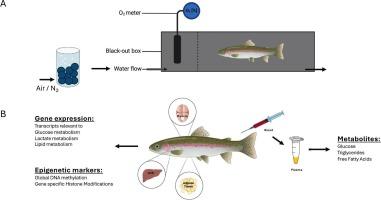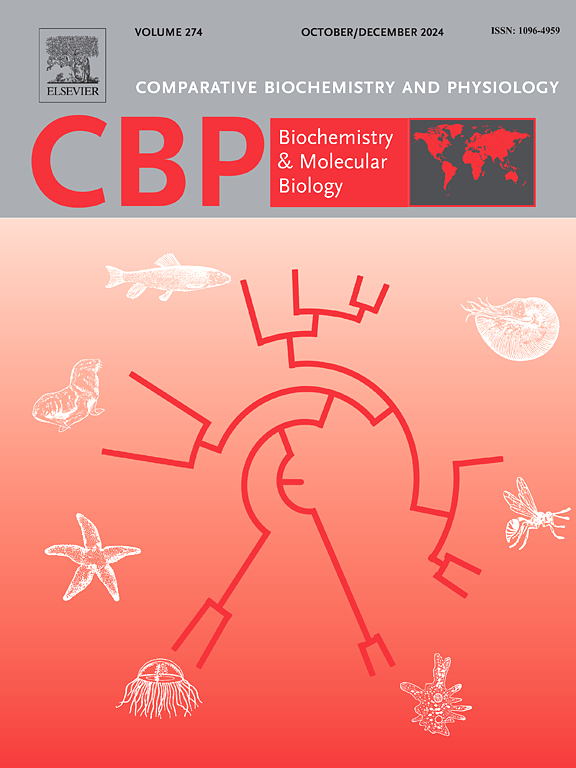虹鳟(Oncorhynchus mykiss)急性缺氧暴露的转录和表观遗传反应。
IF 1.8
3区 生物学
Q4 BIOCHEMISTRY & MOLECULAR BIOLOGY
Comparative Biochemistry and Physiology B-Biochemistry & Molecular Biology
Pub Date : 2025-09-12
DOI:10.1016/j.cbpb.2025.111163
引用次数: 0
摘要
虹鳟鱼相对不耐低氧,面临越来越多的缺氧事件。本研究研究了它们对急性缺氧的代谢和分子反应,并研究了o2依赖性表观遗传标记是否介导了这些反应。成年虹鳟鱼分别暴露于常氧(溶解氧10.5 mg/L)、50% %缺氧(溶解氧5.25 mg/L)和25% %氧饱和度(溶解氧2.61 mg/L)环境4 h。测量血浆代谢物和皮质醇,以及参与氧感应、葡萄糖/乳酸代谢和肝脏、白/红肌肉和脂肪组织脂质代谢的缺氧反应基因的转录本。在肝脏中分析了全局DNA甲基化和启动子特异性组蛋白修饰(H3K4me3)。乳酸和葡萄糖浓度(在较小程度上)增加,而脂质代谢物保持不变。应激激素皮质醇显著升高。在组织水平上,肝脏对缺氧最敏感,并表现出最明显的转录变化。参与乳酸转运和糖酵解的肝脏基因转录本在50% %氧饱和度下增加,而参与糖异生和脂肪酸输入和合成的基因转录本在25% %氧饱和度下被诱导。肝脏整体DNA甲基化保持不变,但在磷酸烯醇丙酮酸羧激酶1基因上观察到启动子特异性的H3K4me3修饰。然而,pck1 H3K4me3启动子占用与pck1表达之间没有明显的直接相关性,提示存在其他转录调控机制。本研究揭示了虹鳟鱼在急性缺氧条件下的组织特异性代谢反应和表观遗传机制,为探讨氧敏感表观遗传标记在其他鱼类缺氧转录反应中的作用铺平了道路。本文章由计算机程序翻译,如有差异,请以英文原文为准。

Transcriptional and epigenetic responses to acute hypoxia exposure in rainbow trout (Oncorhynchus mykiss)
Rainbow trout, which are comparatively intolerant to low oxygen, face increasing hypoxic events. This study investigated their metabolic and molecular responses to acute hypoxia and investigated whether O2-dependent epigenetic marks mediate these responses. Adult rainbow trout were exposed to normoxia (10.5 mg/L dissolved oxygen (DO)), 50 % hypoxia (5.25 mg/L DO) and 25 % oxygen saturation (2.61 mg/L DO) for 4 h. Plasma metabolites and cortisol were measured, as were transcripts of hypoxia-responsive genes involved in oxygen sensing, glucose/lactate metabolism, and lipid metabolism in liver, white/red muscle, and adipose tissue. Global DNA methylation and promoter-specific histone modifications (H3K4me3) were profiled in the liver. Lactate and, to a lesser extent, glucose concentrations increased, while lipid metabolites remained unchanged. The stress hormone cortisol was significantly elevated. At the tissue level, the liver was most sensitive to hypoxia and exhibited the most pronounced transcriptional changes. Hepatic gene transcripts involved in lactate transport and glycolysis increased at 50 % oxygen saturation, while gene transcripts involved in gluconeogenesis and fatty acid import and synthesis were induced at 25 % oxygen saturation. Hepatic global DNA methylation remained unchanged, but promoter-specific H3K4me3 modifications were observed for the phosphoenolpyruvate carboxykinase 1 gene. However, no direct correlation between pck1 H3K4me3 promoter occupancy and pck1 expression was evident, suggesting other transcriptional control mechanisms. This research provides insights into the tissue-specific metabolic responses and epigenetic mechanisms in rainbow trout under acute hypoxia, paving the way for comparative studies probing the role of oxygen-sensitive epigenetic markers in transcriptional responses to hypoxia in other fish species.
求助全文
通过发布文献求助,成功后即可免费获取论文全文。
去求助
来源期刊
CiteScore
4.60
自引率
4.50%
发文量
77
审稿时长
22 days
期刊介绍:
Comparative Biochemistry & Physiology (CBP) publishes papers in comparative, environmental and evolutionary physiology.
Part B: Biochemical and Molecular Biology (CBPB), focuses on biochemical physiology, primarily bioenergetics/energy metabolism, cell biology, cellular stress responses, enzymology, intermediary metabolism, macromolecular structure and function, gene regulation, evolutionary genetics. Most studies focus on biochemical or molecular analyses that have clear ramifications for physiological processes.

 求助内容:
求助内容: 应助结果提醒方式:
应助结果提醒方式:


